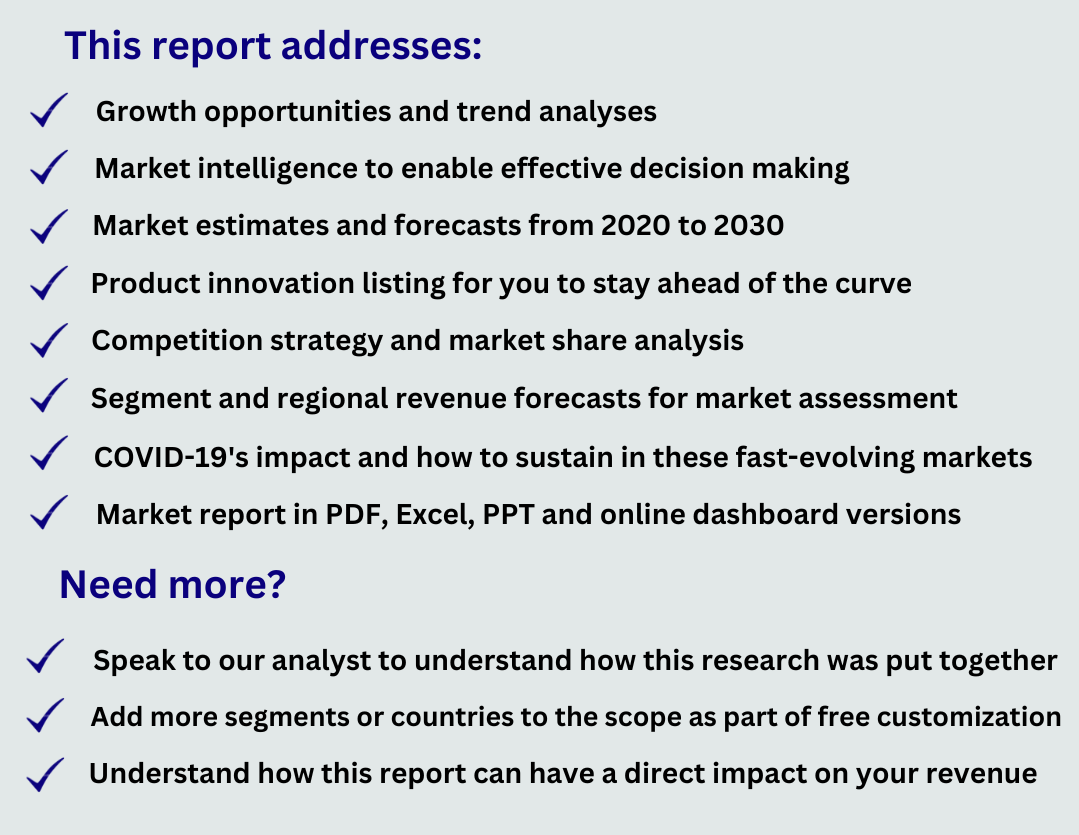Single Vision Lenses Market Status and Trend Analysis 2017-2034 (COVID-19 Version)
Published on: 2024-01-04 | No of Pages : 95 | Industry : Consumer Goods
Publisher : 9 | Format : PDF
Single Vision Lenses Market Status and Trend Analysis 2017-2034 (COVID-19 Version)
Summary
Further key aspects of the report indicate that
Chapter 1Research ScopeProduct Definition, Type, End-Use & Methodology
Chapter 2Global Industry Summary
Chapter 3Market Dynamics
Chapter 4Global Market Segmentation by region, type and End-Use
Chapter 5North America Market Segmentation by region, type and End-Use
Chapter 6Europe Market Segmentation by region, type and End-Use
Chapter 7Asia-Pacific Market Segmentation by region, type and End-Use
Chapter 8South America Market Segmentation by region, type and End-Use
Chapter 9Middle East and Africa Market Segmentation by region, type and End-Use.
Chapter 10Market Competition by Companies
Chapter 11Market forecast and environment forecast.
Chapter 12Industry Summary.
The global Single Vision Lenses market has the potential to grow with xx million USD with growing CAGR in the forecast period from 2021f to 2026f. Factors driving the market for @@@@@ are the significant development of demand and improvement of COVID-19 and geo-economics.

Plastic Single Vision Lenses
Polycarbonate Single Vision Lenses
High-index Single Vision Lenses
Myopia
Hyperopia
Others
North America [U.S., Canada, Mexico]
Europe [Germany, UK, France, Italy, Rest of Europe]
Asia-Pacific [China, India, Japan, South Korea, Southeast Asia, Australia, Rest of Asia Pacific]
South America [Brazil, Argentina, Rest of Latin America]
Middle East & Africa [GCC, North Africa, South Africa, Rest of Middle East and Africa]
Essilor
ZEISS
HOYA
Rodenstock
Nikon
SHAMIR
VISION-EASE LENS
Mingyue
Conant
Wanxin
SEIKO

Further key aspects of the report indicate that
Chapter 1Research ScopeProduct Definition, Type, End-Use & Methodology
Chapter 2Global Industry Summary
Chapter 3Market Dynamics
Chapter 4Global Market Segmentation by region, type and End-Use
Chapter 5North America Market Segmentation by region, type and End-Use
Chapter 6Europe Market Segmentation by region, type and End-Use
Chapter 7Asia-Pacific Market Segmentation by region, type and End-Use
Chapter 8South America Market Segmentation by region, type and End-Use
Chapter 9Middle East and Africa Market Segmentation by region, type and End-Use.
Chapter 10Market Competition by Companies
Chapter 11Market forecast and environment forecast.
Chapter 12Industry Summary.
The global Single Vision Lenses market has the potential to grow with xx million USD with growing CAGR in the forecast period from 2021f to 2026f. Factors driving the market for @@@@@ are the significant development of demand and improvement of COVID-19 and geo-economics.

Based on the type of product
the global Single Vision Lenses market segmented intoPlastic Single Vision Lenses
Polycarbonate Single Vision Lenses
High-index Single Vision Lenses
Based on the end-use
the global Single Vision Lenses market classified intoMyopia
Hyperopia
Others
Based on geography
the global Single Vision Lenses market segmented intoNorth America [U.S., Canada, Mexico]
Europe [Germany, UK, France, Italy, Rest of Europe]
Asia-Pacific [China, India, Japan, South Korea, Southeast Asia, Australia, Rest of Asia Pacific]
South America [Brazil, Argentina, Rest of Latin America]
Middle East & Africa [GCC, North Africa, South Africa, Rest of Middle East and Africa]
And the major players included in the report are
Essilor
ZEISS
HOYA
Rodenstock
Nikon
SHAMIR
VISION-EASE LENS
Mingyue
Conant
Wanxin
SEIKO

